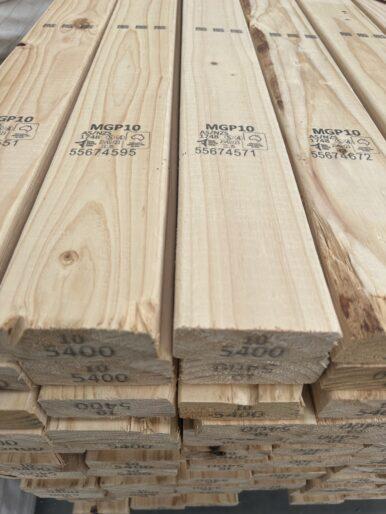- Your cart is empty
- Continue Shopping
Why MGP10’s Machine Grading Makes It Consistently Reliable
When you’re building, the last thing you want is uncertainty about the materials you’re using. Timber might all look the same at first glance, but its strength and reliability can vary a lot.
That’s why structural timber in Australia is graded. It gives builders confidence that the timber they’re working with will do the job it’s meant to do.
MGP10, one of the most common timber grades, has become a trusted choice across the country because of its consistent performance that builders can rely on.
What is MGP10?
MGP stands for Machine Graded Pine, and the “10” is the strength rating. In simple terms, MGP10 is structural pine that has been machine tested for stiffness and strength, giving it reliable and consistent performance. It’s one of the most common grades used across Australian construction and is a go-to choice for framing and general structural work.
MGP10 timber meets strict Australian standards, which means you can rely on it to handle the loads it’s rated for. It’s widely used because it strikes the right balance: strong enough for most residential and light commercial projects, yet affordable and readily available.


Why grading matters and how machine grading makes the difference
Not all timber is the same. Some may look fine on the outside, but internal weaknesses, such as knots or grain variations, can affect its strength. That’s why grading exists: to sort timber into categories based on its actual performance.
In Australia, structural pine is machine graded and classified into grades such as MGP10, MGP12, and MGP15:
- MGP10 – the most commonly used grade, strong enough for most residential and light commercial construction.
- MGP12 – offers higher stiffness and strength, ideal when spans are longer or loads are heavier.
- MGP15 – the highest grade in this range, chosen for demanding structural applications.
The key is how grading is done. Each piece of MGP timber is machine tested for stiffness and strength, ensuring it genuinely meets the requirements of its grade. For builders, this means consistency. You know exactly what to expect when you work with MGP10; no guesswork, no unexpected problems halfway through the job, just timber that performs as it should.
Why reliability matters more than you think
Let’s be honest. Choosing cheaper, ungraded timber might feel like a saving at first. But what happens if you have to redo work because of a structural issue? Or worse, what if it fails completely? That initial saving quickly turns into a much bigger loss.
On the other hand, using MGP10 graded timber gives you peace of mind. You know it meets Australian standards. You know it’s been tested, not just eyeballed. That kind of reliability saves you from costly mistakes and headaches later.


A smarter choice for every builder
In the trade, your reputation depends on quality. Each project you complete reflects your standards. By choosing MGP10 through Timber Central, you’re choosing timber that consistently delivers. It’s one less risk on your plate and one more way to ensure your projects stand strong for years to come.
Ready to make the switch?
Don’t leave your projects open to chance. At Timber Central, we supply MGP10 timber that’s machine graded and consistent every time. Get in touch with us today and secure timber that does the job right, every time.
Frequently Asked Questions
Where is MGP10 timber commonly used?
MGP10 is widely used in residential construction across Australia. You can see it in wall frames, floor joists, roof trusses, and other general structural applications where strength and consistency are required.
Does MGP10 meet Australian standards?
Yes. MGP10 timber is graded in line with Australian Standards (AS/NZS 1748), ensuring it meets the required structural performance criteria.
Is MGP10 strong enough for all projects?
MGP10 is suitable for most residential and light commercial work. For heavier loads or larger spans, a higher grade like MGP12 may be specified. Always check your project requirements against Australian Standards.

